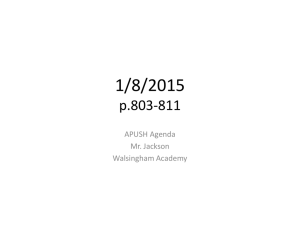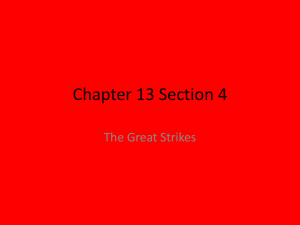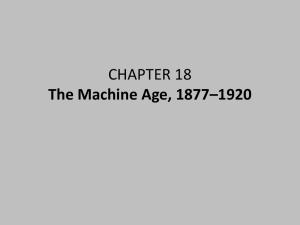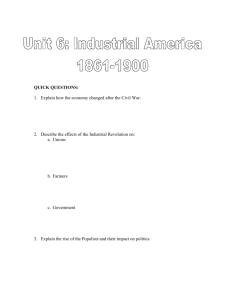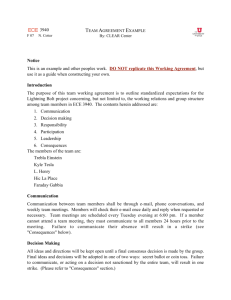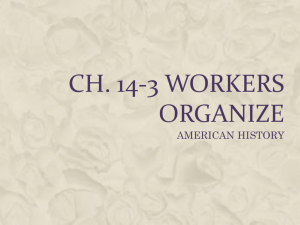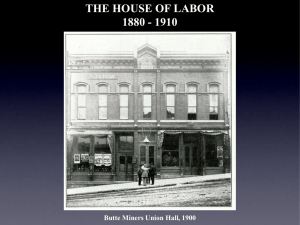Rise of American Labor
advertisement
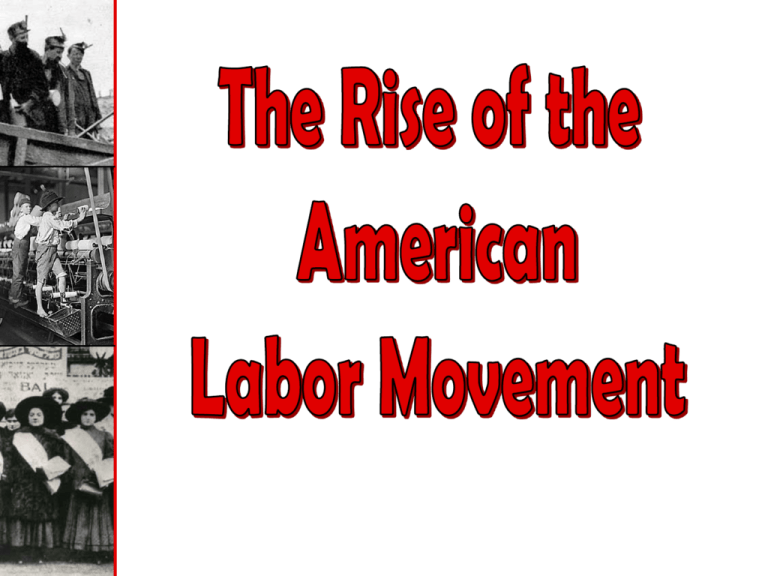
The life of a 19th-century American industrial worker was hard. Even in good times wages were low, hours long, and working conditions hazardous. Little of the wealth that the growth of the nation had generated went to its workers. Moreover, women and children made up a high percentage of the work force in some industries and often received but a fraction of the wages a man could earn. Periodic economic crises swept the nation, further eroding industrial wages and producing high levels of unemployment. National Labor Union The NLU was created in 1866 and dissolved in 1873.With the U.S. economy becoming increasingly industrialized, the struggle between labor and factory owners began. Labor Unions were formed to seek better working conditions, better wages and shorter working hours. The NLU was formed by an ironworker named William H. Sylvis. It consisted of about 300 local unions in thirteen states. The laissez-faire capitalism that dominated the second half of the 19th century and fostered huge concentrations of wealth and power was backed by a judicial branch that time and again ruled against those who challenged the system. In this, they were merely following the philosophy of the times: the US government forcefully put down labor unrest. Labor Unrest: 1870-1900 Management vs. Labor “Tools” of Management “Tools” of Labor “scabs” boycotts P. R. campaign sympathy demonstrations Pinkertons lockout blacklisting yellow-dog contracts informational picketing closed shops court injunctions organized strikes open shop “wildcat” strikes Knights of Labor Terence V. Powderly An injury to one is the concern of all! The first major effort to organize workers’ groups on a nationwide basis appeared with the Noble Order of the Knights of Labor in 1869. It was a union open to all workers, including African Americans, women, and farmers. The Knights grew slowly until its railway workers’ unit won a strike against the great railroad baron, Jay Gould, in 1885. Within a year they added 500,000 workers to their rolls. Goals of the Knights of Labor ù Eight-hour workday. ù Abolition of child and prison labor. ù Increased circulation of greenbacks. ù Equal pay for men and women. ù Safety codes in the workplace. ù Prohibition of contract foreign labor. The Haymarket Square Riot This was an outbreak of violence in Chicago on May 4, 1886. A demonstration, largely staged by a small group of anarchists, caused a crowd of some 1,500 people to gather at Haymarket Square. When policemen attempted to disperse the meeting, a bomb exploded and rioting ensued. Seven policemen and four other persons were killed, and more than 100 persons were wounded. The incident was frequently used by the adversaries of organized labor to discredit the waning Knights of Labor movement. The American Federation of Labor: 1886 Samuel Gompers Opposed to the idea of a labor party, the AFL (1886) was a relatively conservative political force within the labor movement of the late 19th and early 20th cent. But the union did help secure for its members higher wages, shorter hours, workmen’s compensation, laws against child labor, an 8-hr day for government employees, and the exemption of labor from antitrust legislation. How the AF of L Would Help the Workers ù Catered to the skilled worker. ù Represented workers in matters of national legislation. ù Prevented disputes among the many craft unions. ù Mediated disputes between management and labor. ù Pushed for closed shops. Strikes The Great Railroad Strike of 1877 In 1877, the nation was struck by another recession, which was called a panic at that time. A strike by railroad workers sparked a coastto-coast conflagration, as workers driven by despair and desperation battled troops in the streets of major U.S. cities. The Great Railroad Strike of 1877 was the first major strike in an industry that propelled America’s industrial revolution. It was the first national strike, stretching from Atlantic to Pacific. In some cities, especially St. Louis, the struggle became one of the nation’s first general strikes. This was the first major strike broken by the U.S. military. Probably in no other strike had so many working people met a violent death at the hands of the authorities: 100 were killed; 1,000 arrested. In 1892, at Carnegie’s steel works in Homestead, Pennsylvania, a group of 300 Pinkerton detectives the company had hired to break a bitter strike by the Amalgamated Association of Iron, Steel, and Tin Workers fought a fierce and losing gun battle with strikers. The National Guard was called in to protect non-union workers and the strike was broken. Unions were not let back into the plant until 1937. In 1894, wage cuts at the Pullman Company just outside Chicago led to a strike, which, with the support of the American Railway Union, soon tied up much of the country’s rail system. As the situation deteriorated, U.S. Attorney General Richard Olney, himself a former railroad lawyer, deputized over 3,000 men in an attempt to keep the rails open. This was followed by a federal court injunction against union interference with the trains. When rioting ensued, President Cleveland sent in federal troops, and the strike was eventually broken. Eugene Debs, the leader of the American Railway Union was arrested and placed in jail for six months. President Grover Cleveland If it takes the entire army and navy to deliver a postal card in Chicago, that card will be delivered! The Gilded Age was a period of horrific labor violence, as industrialists and workers literally fought over control of the workplace Workers organized the first large American labor unions during the Gilded Age Employers were generally just as determined to stop unionization as workers were to organize unions, leading to frequent conflict Strikes were often stopped by the state and federal government by court injunction or by violence. The AFL would survive and flourish from the 1800s to the 1900s, and still exists today.

